9.3 Backing up the Exchange Information Store
|
| < Day Day Up > |
|
Performing regular backups of the Exchange Information Store is an important part of creating a fault-tolerant messaging environment. You should schedule a daily normal (full) backup of the Information Store. Scheduling the backup reduces the amount of human interaction and reduces the possibility that someone may forget to perform the backup. As with any type of backup, it is important that you always verify the success of the backup operation.
Exchange is designed to be backed up while it is running. You do not— and should not—stop any Exchange services or dismount any Exchange databases when you do a backup. Because Exchange is still running, your users can continue to send and receive e-mail while the backup is in progress. You can use the following procedure to schedule backups for an Exchange Information Store.
-
Start the Backup process from the Windows Start menu by selecting All Programs →Accessories →System Tools →Backup (Figure 9.2).
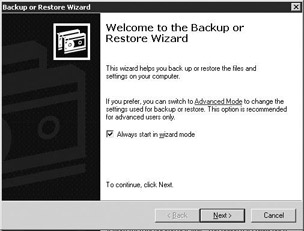
Figure 9.2: Welcome to the Backup or Restore Wizard -
On the Backup or Restore Wizard Welcome window, select Advanced Mode to start the Backup Utility (Figure 9.3).
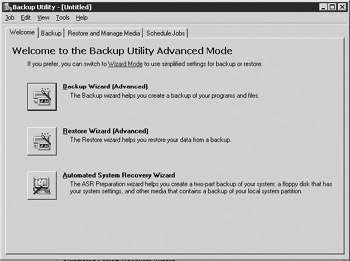
Figure 9.3: Backup Utility – Welcome tabNote If you clear the Always start in wizard mode check box, you can avoid the Welcome to the Backup or Restore Wizard window in the future by going directly to the Backup Utility.
-
In the Backup Utility window, select the Backup tab (Figure 9.4).
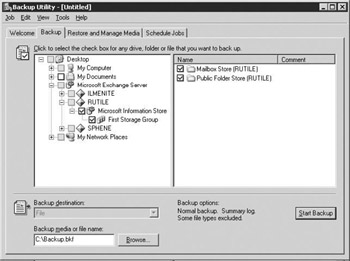
Figure 9.4: Backup Utility – Backup tab -
Expand the Microsoft Exchange Server section to display the Exchange servers in your organization.
-
Expand the server containing the Information Store you want to back up.
-
Expand the Microsoft Information Store section to display the Storage Groups contained within the Information Store.
-
You can back up the entire Information Store, selected Storage Groups, or selected databases. If you select multiple databases, Backup will write them to the backup media one after another.
-
Select Microsoft Information Store to back up all Storage Groups and databases within the Information Store.
-
Select a Storage Group to back up all databases within the Storage Group.
-
In the details pane, select a database to back up the single database.
Because all databases in a storage group share the same set of transaction log files, you can improve the speed of the backup process by backing up an entire storage group at the same time.
-
-
Use the Backup destination drop-down list to select a backup device or file where the backup data will be written. If you do not have a backup device, the Backup Utility automatically selects File by default.
-
Use the Browse button to enter the file name for the new backup file into the Backup media or file name field.
-
Select the Start Backup button to display the Backup Job Information dialog box (Figure 9.5).

Figure 9.5: Backup Job Information dialog box -
The Backup description field contains the default description of the backup set. You can change this description if necessary.
-
If the backup media or file contains a previous backup, select one of the following options:
-
Select Append this backup to the media to keep the previous backup and append the new backup.
-
Select Replace the data on the media with this backup to replace the previous backup.
-
-
If you are creating a new backup (i.e., you are not appending this backup to a previous one), you can select the Allow only the owner and the Administrator access to the backup data check box to limit access to the backup.
-
The field near the bottom of the dialog box contains the default label that will be used to identify the media. You can change this description if necessary.
-
Select the Advanced button to display the Advanced Backup Options dialog box (Figure 9.6).
-
Use the Backup Type drop-down list to select the type of backup you want to perform. The choices are Normal, Copy, Incremental, Differential, or Daily. Normal backups (also known as full backups) are strongly recommended for two primary reasons:
-
Normal backups minimize the number of tapes required to recover data, thus minimizing the time required to recover the data. Both incremental and differential backups require multiple tapes to recover the same amount of data.
-
After backing up the transaction log files, the normal backup deletes the log files from the disk, thus recovering the disk space.
Exchange continues to run and database changes can occur during the backup process. To capture these changes, the database engine maintains a patch file that logs these last minute changes. The backup utility writes the patch file to the backup media after copying the transaction log files.
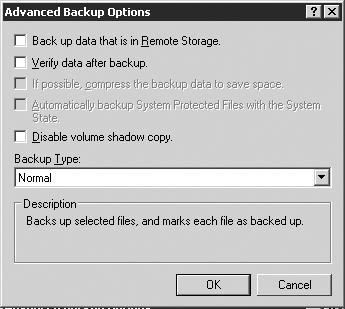
Figure 9.6: Advanced Backup Options dialog box -
-
Select the Verify data after backup check box. Verification reads the backed up data to verify its integrity. This takes extra time, but it helps to ensure that you will be able to recover data from this backup media.
-
If you are using a tape drive capable of compressing the data, you can select the If possible, compress the backup data to save space check box. Compression allows you to store more data on the backup tape. However, you can only restore compressed backup tapes using drives that support the same type of compression.
-
Select OK to return to the Backup Job Information dialog box.
-
Select the Schedule button.
-
The Backup Utility will ask you to save the current backup job information and will display a Set Account Information dialog box asking for an account and password. The account will be used to run the backup job. Enter the account and password for the backup job security context. Once you have entered the account information, the Backup Utility will display the Scheduled Job Options dialog box (Figure 9.7).

Figure 9.7: Schedule Job Options dialog box -
In the Job name field, enter a name for this backup job.
-
Select Properties to display the Schedule Job dialog box (Figure 9.8).
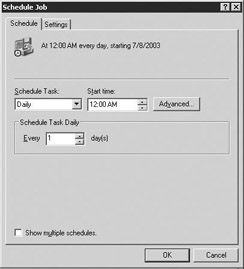
Figure 9.8: Schedule Job dialog box -
You can use the Schedule Task drop-down list to elect to perform the backup just once, daily, weekly on selected days, or monthly on selected days of the month. For each of these options, you can specify the time when the backup should start. Optionally, you can select to perform the backup each time the system starts up, each time you log on to the system, or whenever the system is idle for a specified number of minutes. Because backups can affect server performance, you should schedule the backup for a time when there is moderate to low load. Select OK when you have selected the appropriate schedule.
-
The Backup Utility will display a Set Account Information dialog box asking for an account and password. The account will be used to run the backup job. Enter the account and password for the backup job security context. Once you have entered the account information, the Backup Utility will return to the Scheduled Job Options dialog box (see Figure 9.7).
-
Select OK on the Schedule Job Options dialog box. The Backup Utility will schedule the backup for the time you selected.
|
| < Day Day Up > |
|
EAN: 2147483647
Pages: 128
- Chapter IV How Consumers Think About Interactive Aspects of Web Advertising
- Chapter V Consumer Complaint Behavior in the Online Environment
- Chapter VII Objective and Perceived Complexity and Their Impacts on Internet Communication
- Chapter VIII Personalization Systems and Their Deployment as Web Site Interface Design Decisions
- Chapter XI User Satisfaction with Web Portals: An Empirical Study